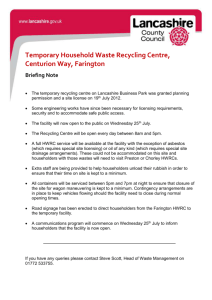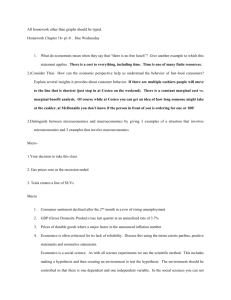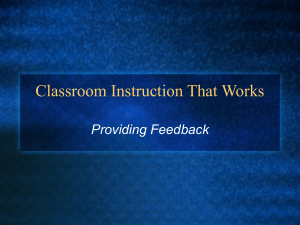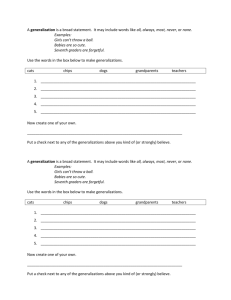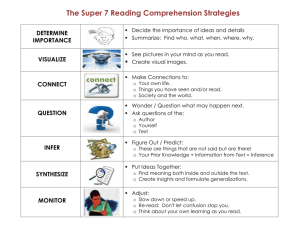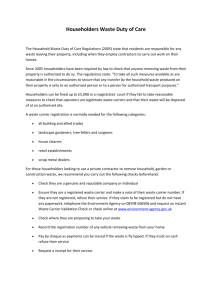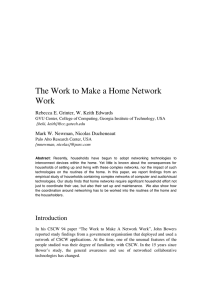These statements are concerned with what the economy should
advertisement
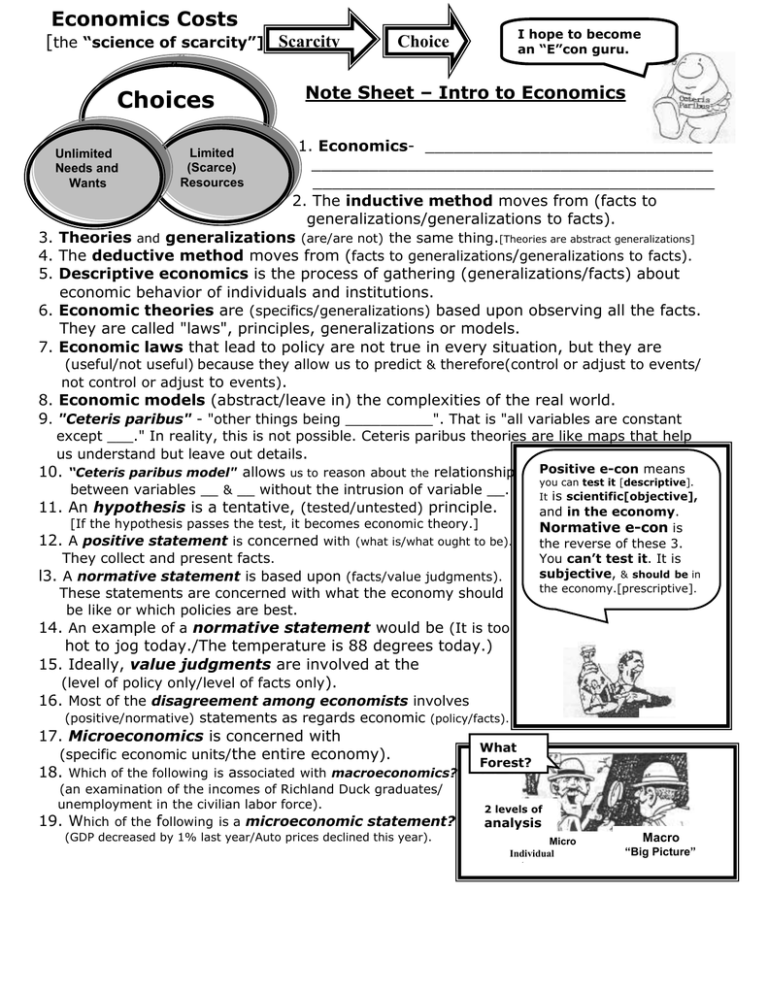
Economics Costs [the “science of scarcity”] Scarcity Choices 6. 7. Note Sheet – Intro to Economics 1. Economics- ______________________________ __________________________________________ __________________________________________ 2. The inductive method moves from (facts to generalizations/generalizations to facts). Theories and generalizations (are/are not) the same thing.[Theories are abstract generalizations] The deductive method moves from (facts to generalizations/generalizations to facts). Descriptive economics is the process of gathering (generalizations/facts) about economic behavior of individuals and institutions. Economic theories are (specifics/generalizations) based upon observing all the facts. They are called "laws", principles, generalizations or models. Economic laws that lead to policy are not true in every situation, but they are Unlimited _ Needs_and _ Wants 3. 4. 5. I hope to become an “E”con guru. Choice s Limited (Scarce) Resources (useful/not useful) because they allow us to predict & therefore(control or adjust to events/ not control or adjust to events). 8. Economic models (abstract/leave in) the complexities of the real world. 9. "Ceteris paribus" - "other things being __________". That is "all variables are constant except ___." In reality, this is not possible. Ceteris paribus theories are like maps that help us understand but leave out details. Positive e-con means 10. “Ceteris paribus model" allows us to reason about the relationship you can test it [descriptive]. between variables __ & __ without the intrusion of variable __. It is scientific[objective], 11. An hypothesis is a tentative, (tested/untested) principle. and in the economy. [If the hypothesis passes the test, it becomes economic theory.] Normative e-con is 12. A positive statement is concerned with (what is/what ought to be). the reverse of these 3. They collect and present facts. You can’t test it. It is subjective, & should be in l3. A normative statement is based upon (facts/value judgments). the economy.[prescriptive]. These statements are concerned with what the economy should be like or which policies are best. 14. An example of a normative statement would be (It is too hot to jog today./The temperature is 88 degrees today.) 15. Ideally, value judgments are involved at the (level of policy only/level of facts only). 16. Most of the disagreement among economists involves (positive/normative) statements as regards economic (policy/facts). 17. Microeconomics is concerned with (specific economic units/the entire economy). 18. Which of the following is associated with macroeconomics? What what Forest? (an examination of the incomes of Richland Duck graduates/ unemployment in the civilian labor force). 19. Which of the following is a microeconomic statement? 2 levels of (GDP decreased by 1% last year/Auto prices declined this year). analysis Micro Individual components Macro “Big Picture” “Chuckholes to Economic Thinking” Now, I see things in a different light. No more chuckholes. You must read the economics textbook. “Direct” [Positive relationship] Y “No relationship” [Increasing X has no effect on Y] $10 “Zero Slope” X 0 Calories consumed C X 0 100 200 300 400 Crime rate in Dallas Y “Inverse” D Y “No relationship” [Negative relationship] [Incr.Y has no effect on X] $14 $12 $10 $8 $6 X 0 Ave miles jogged Infinite slope Body Weight Y B Body Weight A $ of Tea in China 20. Bias – preconceptions that (are/are not) based on facts. 21. Loaded terminology - (emotional/non-emotional) terms leading to a nonobjective analysis. 22. Definitions - economic words have different meanings. Ex: "utility" means (extra/ satisfaction); “investment" means (money/tools, machinery, & factories); "price floors" are (above/below) "price ceilings". X 400 23. In which graph above is the amount of “Y” inversely related to the amount of “X”? ___ 24. In which graph above is the amount of “Y”[constant at $10] unrelated to the increasing amount of “X”? ____ 25. In which graph above is the amount of “Y” directly related to the amount of “X”? ____ Chapter 2 - The Economizing Problem[Dealing with scarcity] ["Scarcity, choices, and costs are the building blocks of this chapter.] 33. The economizing problem is deciding how to make the best use of (limited/unlimited) resources to satisfy (limited/unlimited) wants. 34. Money is not considered an economic resource because money (is/is not) productive. The process of accumulating capital goods (tools, machinery, & factories) is (depreciation/investment). 35. Give examples of real capital. A._________ B. _________ Land Labor Capital Not only do I want a cracker-we all want a cracker. Entrepreneur 36. The payments for the 4 factors of production are: 37. The PPC illustrates the principle that if all resources of an economy are in use, more of one good can be produced only if (more/less) of another good is produced. 38. Give two reasons that could shift the PPC outward. ____________ ___________ 39. The opportunity (cost/benefit) is the best alternative foregone. [2nd best choice] 40. At what point is there unemployment[recession]?___ 41. What points are resources being used in their most 42. At what point is there an improvement in technology, therefore a new PPC frontier line? _____ 43. The (straight line/curve) illustrates the "line of increasing (opportunity) cost"? ____ 44. The (straight line/curve) illustrates the "law of constant cost"? [equally substitutable] ___ 45. At what point would there be the most economic growth in the future if a country were producing there now? ___ 46. What is the opportunity cost(what is given up) when moving from point "C" to "D"? ___ Capital Goods productive manner?[full employment & full production with best technology] __________ A B G C F D E Consumer goods 47. Refer to the PPC graph. The U.S. entered WWII from the Great Depression. Therefore it moved from letter ___(Gr. Depression) to letter ___ [full employment with a good mix of wartime and civilian goods]. 48. Refer to graph. As WWII started, the Soviet Union was at full employment. If "C" & "D" were the only 2 letters on the curve, they would have moved from letter ___ to ___. 49. A reduction in unemployment will (push out the PPC/get us closer to where we should be on the PPC). Chapter 4 - Pure Capitalism & the Circular Flow 50. The following is unique to capitalist ideology: (use of money/specialization/ private ownership of property resources). 51."Roundabout production"(assembly line) leads to (use of fewer capital goods/greater production) Crusoe [for questions 52-55] Has surplus fish Wants coconuts Friday Saturday Has surplus coconuts Wants bananas Has surplus bananas Wants fish 52. Crusoe would get coconuts from (Friday/Saturday). 53. There (is/is no) coincidence of wants between any 2 states. 54. Money would flow (clockwise/counterclockwise). 55. The "coincidence of wants" problem means each transactor (must/must not) have a product which the other wants. 3 GDP Rent, Wages, Profits, Interest Resource Market Households 1 GDI Land, Labor, & Entrepreneurship Fuzzy Wuzzy Product Consumer Expenditures Market 4 2 Capital, Goods & Services Businesses [Firms] 56. In the product market of the circular flow model (householders/businesses) are the demanders and (householders/businesses) are the suppliers. 57. In the resource market of the circular flow model (householders/businesses) are the demanders and (householders/businesses) are the suppliers. 58. In the resource market, (householders/businesses) sell resources to (householders/businesses). 59. In the product market, (householders/businesses) sell products[goods/services] to (householders/businesses). $ S(Consumers) D(Businesses) GDI Households $ Resource Market 1 2 Circular Flow Businesses 3 4 Product Market 60. Which flow above represents goods/services being sold? ____ 61. Which flow above represents consumers buying products? ___ 62. Which flow above represents land, labor, capital, & entrepreneurial ability? ___ 63. Which flow above represents wages, rents, interest, & profits? ____
